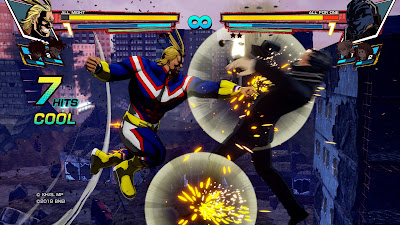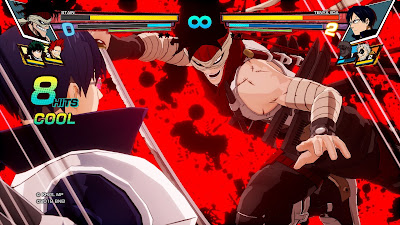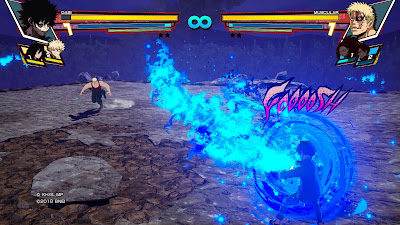My Hero One’s Justice is a fighting game based upon the popular anime My Hero Academia (not sure why they butchered the title of this game so that it cuts out part of the anime’s title and does not make much sense in English either). Like many anime inspired games, it is a 3D brawler arena fighting game. The roster is fairly good, covering most of the main characters up to, and including, Season 3 of the anime. However, it’s still only twenty characters which means you’ll end up quickly running out of new characters to try.
There is a story mode that runs through the events of Seasons 2 and 3 of the anime. It’s a weird decision to pick those parts, as it starts during the middle of Season 2 (but will end up quickly covering the start of it as well), with only a 2 minute summary of the setting and background of the story. So if you have never seen the anime before, then it is confusing, and if you have watched the anime, it’s told too quickly to build the same level of hype and emotions that the anime did. It covers up until the middle of Season 3, with an unsatisfactory climax cutscene, especially compared to the anime. All in all, the story mode is there because the developers needed to put some single player content, and truth be told, it could have been a lot worse.
The story is told via static cutscenes that mimic comic book / manga panels, which suits the source material perfectly. It’s completely voiced, with Japanese voiceovers only, and uses the same voice actors as the anime. There will be some scenes where it uses the 3D models of the game but those are rare. This is the part where it is understandable why the developers started midway through the second season, since it’s where the fights start to occur more frequently, and so can pace the story better.
The story mode is structured in such a way that you select the mission, watch a short cutscene before, play the battle, and then watch a cutscene after. It’s simple but it works. As a fighting game, the controls make or break the game. As a casual player, it’s very easy to pick up the game. From its roster of twenty characters, each character has your basic attack, block and dash. What sets each one apart are their quirks, the in-universe terminology for each character’s superpowers.
The cool thing with the game is that some thought was given in how to adapt each character’s quirks into their moveset. It does make everyone unique in their playstyle. We have Ida who’s built for speed, and then Kaminari who after using his ultimate move, will lose control for a while as he “fries his brains”, just like the anime. Each character has two quirk attacks mapped to two face buttons, with future Plus Ultra moves once certain gauges are full.
Furthermore, you can bring in sidekicks. There are gauges that charge and once it’s full, you can summon the sidekicks to attack before disappearing again. It’s a fun system even if you’re not proficient at it, although you have to get used to how the camera works. It doesn’t follow behind your character, rather it likes to follow behind your opponent instead, so it can feel weird. Once you complete a match, you get graded based on the variety of your moves, and other techniques that you’ve used.
You will need to be familiar with the characters that you end up using. Each character has a different attacking range and so can be really annoying when you fire off an ultimate attack, only for it to miss, or even worse, be cut short when the opponent hits you. Characters’ attack start up animations also vary quite a bit, you might be surprised when using a new character how slow they may attack and so get counterattacked relentlessly by your opponent. The AI also tends to like to constantly run around the arena, which is really annoying when most characters’ attack ranges are short. If you end up dashing towards them recklessly, you’ll get combo’d. It’s little things like these that makes the game rough.
The graphics are decent, it matches it’s source material fairly well. The stages are inspired by the events in the story mode, so you’ll get to fight in Gran Torino’s room, or in the alleyway against Stain, or at U.A.. Yes, the environments can look simple and drab, but this is obviously a lower budget game so you’ll have to end up giving it some slack.
The story mode isn’t too long, there are actually two sides of the story, the Hero Side and the Villain Side. As you can guess, it tells the same events, but from the different viewpoints of the heroes and villains. While it closely follows the anime, there are some minor points where it explores a little bit more, but it’s so minor that it’s not really worth playing through the whole thing just to see if you weren’t interested. Each side takes around two to three hours, so all told, it’s four to six hours of story content, which isn’t too bad, although you have to consider it is repetitive stuff (cutscenes and single battles).
There are a few other modes to try out once you’ve finished the story. The Arcade mode pits you against six CPU opponents. Completing it unlocks more cosmetics items to dress up the characters. Cosmetics are a big thing with the game, as they are the primary form of rewards. The Training mode allows you to practice moves against a CPU opponent. Local allows you to fight either CPU opponents or another player locally using a second controller. Online is self-explanatory, as you battle against others on the internet. You also earn coins for everything you do in the game which is used to unlock more items.
The Mission mode is the other meaty single player mode. It presents you a “map”, filled with “missions”. These are just fanciers terms for a chain of battles in order to progress to the end. You gain points in each mission and get a final grade at the end. It also includes some minor RPG elements, such as experience points and increasing the levels of the characters. This is where the downside is, as there are only six maps, but they rapidly scale up in level requirements that it is practically compulsory to grind levels so that you don’t die in one combo on the higher difficulties. Each mission may also have a different win condition like no guarding or the opponent have increased defence. You can use items to remove some of these barriers but it does feel too grindy in the end.
Overall, My Hero One’s Justice is a passable first attempt at a fighting game based upon the popular manga and anime series. You have to be a fan to fully appreciate the game, but you’ll still have some fun if you aren’t. Being a fighting game, it can get repetitive if you only play the single player stuff, such as the Story and Mission modes, however, the game does provide quite a bit of content, more than you would expect. The game mechanics are easy enough to pick up but will seem clunkier than expected at first, so you will require some time to get used to it. It’s far from being an amazing game but you will still have some enjoyment out of playing it.
-----------------------------------------------------------
For other game reviews, have a look at this page.
(As an Amazon Associate I earn from qualifying purchases)












